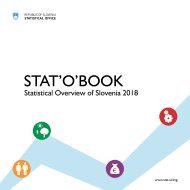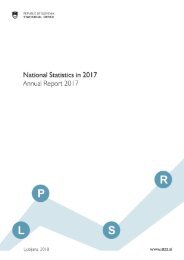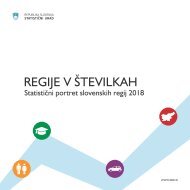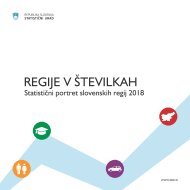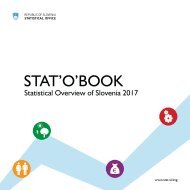quality-indicators-2017
You also want an ePaper? Increase the reach of your titles
YUMPU automatically turns print PDFs into web optimized ePapers that Google loves.
QUALITY INDICATORS <strong>2017</strong><br />
Example 2: If in a yearly survey the year of the first comparable release of results is 1998, upon the release of<br />
the results for 2009 the indicator value is equal to P 1 12<br />
(years).<br />
3.15 Coherence between provisional and final data (S1)<br />
3.15.1 Description<br />
The absolute and the relative differences between the value of statistics upon the first release and the value<br />
upon the release of the final data. As revisions, only those corrections are considered which are part of the<br />
regular procedure for the repeated releases of statistical results. Corrections due to discovered errors do not<br />
apply to this category and are not considered in the calculation of the indicator.<br />
Even if the revision policy determines several versions of (provisional) data for the same reference period, for<br />
reason of simplicity, only the difference between the value of the first and the value of final release are<br />
calculated.<br />
The indicator value refers to key statistics.<br />
3.15.2 Calculation procedure<br />
Let us say that X<br />
z<br />
is the first and X<br />
k<br />
the final value of the released statistical result (statistic). The calculation<br />
of the indicator is classified with regard to the type of statistical result.<br />
If the released result is a "dimensionless" statistic (e.g. rate, index), the indicator value is calculated as the<br />
absolute difference:<br />
S<br />
1 .<br />
X k<br />
X z<br />
If the released result is a "dimensional" statistic (e.g. sum, average), the indicator value is calculated as the<br />
relative difference:<br />
S<br />
X<br />
X<br />
k z<br />
1 .<br />
X<br />
k<br />
3.15.3 Explanation and calculation examples<br />
Instead of the title coherence between the final and provisional results, the indicator could also be referred to as<br />
coherence between the most recently released results and the provisional results. Since we usually calculate<br />
the value of indicator S1 after the release of the final results, the most recently released results are also the final<br />
results.<br />
In particular in short-term statistics, the results for the same reference period are released several times<br />
(sometimes also more than 10 times). In such cases, at each release of results the difference compared to the<br />
first released result could be calculated. In order to simplify the calculation and to provide clarity, the indicator is<br />
only defined as the (relative) difference between the first and final releases. In such cases, a supplementary<br />
indicator can also be calculated and released, for example, the maximum deviation of the last release from the<br />
first release, which would be calculated as max X m i<br />
X z<br />
, where m is the number of releases of statistical<br />
i<br />
1<br />
results (for the same reference period) after the first release of results.<br />
Example 1: In this case, (hypothetical) first and final results in the monthly survey are stated for all months in<br />
2008. Since the results are indices, the indicator value is calculated as the absolute difference. The average<br />
(annual) value of the indicator is also given.<br />
24





